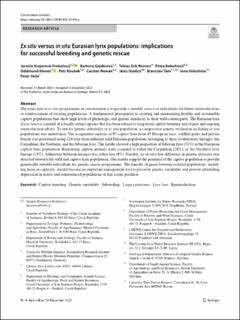| dc.contributor.author | Krojerová‑Prokešová, Jarmila | |
| dc.contributor.author | Gajdárová, Barbora | |
| dc.contributor.author | Reiners, Tobias Erik | |
| dc.contributor.author | Bolechová, Petra | |
| dc.contributor.author | Kleven, Oddmund | |
| dc.contributor.author | Koubek, Petr | |
| dc.contributor.author | Nowak, Carsten | |
| dc.contributor.author | Ozoliņš, Jānis | |
| dc.contributor.author | Tám, Branislav | |
| dc.contributor.author | Voloshina, Inna | |
| dc.contributor.author | Vallo, Peter | |
| dc.coverage.spatial | Eurasia | en_US |
| dc.date.accessioned | 2023-01-03T09:25:59Z | |
| dc.date.available | 2023-01-03T09:25:59Z | |
| dc.date.created | 2023-01-02T13:13:09Z | |
| dc.date.issued | 2022 | |
| dc.identifier.issn | 1566-0621 | |
| dc.identifier.uri | https://hdl.handle.net/11250/3040505 | |
| dc.description.abstract | The main aim of ex situ programmes in conservation is to provide a suitable source of individuals for future reintroductions or reinforcement of existing populations. A fundamental prerequisite is creating and maintaining healthy and sustainable captive populations that show high levels of phenotypic and genetic similarity to their wild counterparts. The Eurasian lynx (Lynx lynx) is a model of a locally extinct species that has been subject to long-term captive breeding and of past and ongoing reintroduction eforts. To test for genetic suitability of ex situ population, a comparative genetic evaluation including in situ populations was undertaken. The assignment analysis of 97 captive lynx from 45 European zoos, wildlife parks and private breeds was performed using 124 lynx from diferent wild Eurasian populations belonging to three evolutionary lineages: the Carpathian, the Northern, and the Siberian lynx. The results showed a high proportion of Siberian lynx (51%) in the European captive lynx population. Remaining captive animals were assigned to either the Carpathian (28%), or the Northern lynx lineage (13%). Admixture between lineages was rather low (8%). Notably, no or very low diference in genetic diversity was detected between the wild and captive lynx populations. Our results support the potential of the captive population to provide genetically suitable individuals for genetic rescue programmes. The transfer of genes between isolated populations, including those in captivity, should become an important management tool to preserve genetic variability and prevent inbreeding depression in native and reintroduced populations of this iconic predator. Captive breeding · Genetic variability · Inbreeding · Large carnivores · Lynx lynx · Reintroduction | en_US |
| dc.language.iso | eng | en_US |
| dc.rights | Navngivelse 4.0 Internasjonal | * |
| dc.rights.uri | http://creativecommons.org/licenses/by/4.0/deed.no | * |
| dc.subject | Captive breeding | en_US |
| dc.subject | Genetic variability | en_US |
| dc.subject | Inbreeding | en_US |
| dc.subject | Large carnivores | en_US |
| dc.subject | Lynx lynx | en_US |
| dc.subject | Reintroduction | en_US |
| dc.title | Ex situ versus in situ Eurasian lynx populations: implications for successful breeding and genetic rescue | en_US |
| dc.title.alternative | Ex situ versus in situ Eurasian lynx populations: implications for successful breeding and genetic rescue | en_US |
| dc.type | Peer reviewed | en_US |
| dc.type | Journal article | en_US |
| dc.description.version | publishedVersion | en_US |
| dc.rights.holder | © 2022 The Authors | en_US |
| dc.subject.nsi | VDP::Zoologiske og botaniske fag: 480 | en_US |
| dc.subject.nsi | VDP::Zoology and botany: 480 | en_US |
| dc.source.journal | Conservation Genetics | en_US |
| dc.identifier.doi | 10.1007/s10592-022-01494-y | |
| dc.identifier.cristin | 2098812 | |
| dc.relation.project | Andre: INTER-EXCELLENCE - INTER-COST (LTC20021) | en_US |
| dc.relation.project | Andre: Ministry of the Environment of the Czech Republic | en_US |
| dc.relation.project | Andre: EEA grants (project MGSII-40) | en_US |
| dc.relation.project | Andre: Institutional Research Plan (RVO: 68081766) | en_US |
| cristin.ispublished | true | |
| cristin.fulltext | original | |
| cristin.qualitycode | 1 | |

